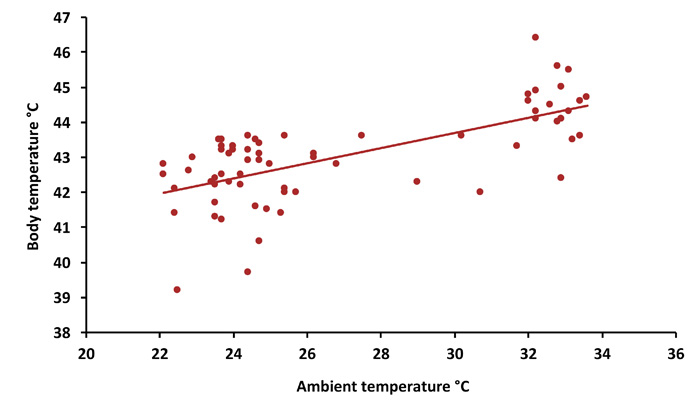| Follow @co2science |
Paper Reviewed
Nilsson, J.-A., Molokwu, M.N. and Olsson, O. 2016. Body temperature regulation in hot environments. PLOS ONE 11(8): eO161481.doi:1371/journal.pone.0161481.
Introducing their work, Nilsson et al. (2016) write that in a warming world, many organisms in hot environments will not be able to passively dissipate metabolically generated heat," noting that they will instead have to revert to evaporative cooling, which they say is "energetically expensive and promotes excessive water loss." So how is this dilemma to be resolved?
The three researchers report that they broached the subject by exploring "the use of hyperthermia in wild birds captured during the hot and dry season in central Nigeria," which work revealed the presence of (1) "pronounced hyperthermia in several species with the highest body temperatures close to predicted lethal levels," plus the fact that (2) "birds let their body temperature increase in direct relation to ambient temperatures, increasing body temperature by 0.22°C for each degree of increased ambient temperature" (see figure below), while noting that (3) "to offset the costs of thermoregulation in ambient temperatures above the upper critical temperature, birds are willing to let their body temperatures increase by up to 5°C above normal temperatures."
In further commenting on the subject of their study, Nilsson et al. state that "this flexibility in body temperatures may make birds well adapted to meet future global increases in ambient temperature," also noting in this regard the similar prior conclusions of Khaliq et al. (2014) and Thompson et al. (2015).

Relationship between ambient temperature in the shade and body temperature. Data from 69 individual birds from 13 different species. Equation of the line: Body temperature = 37.2 + 0.22(ambient temperature); R2 = 0.45. Source: Nilsson et al. (2016).
References
Khaliq, I., Hof, C., Prinzinger, R., Bophning-Gaese, K. and Pfenninger, M. 2014. Global variation in thermal tolerances and vulnerability of endotherms to climate change. Proceedings of the Royal Society B 281: doi: 10.1098/rspb.2014.1097.
Thompson, L.J., Brown, M. and Downs, C.T. 2015. The potential effects of climate-change-associated temperature increases on the metabolic rate of a small Afrotropical bird. Journal of Experimental Biology 218: 1504-1512.
Posted 5 December 2016



